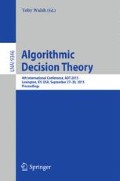Abstract
Most of the computational study of election problems has assumed that each voter’s preferences are, or should be extended to, a total order. However in practice voters may have preferences with ties. We study the complexity of manipulative actions on elections where voters can have ties, extending the definitions of the election systems (when necessary) to handle voters with ties. We show that for natural election systems allowing ties can both increase and decrease the complexity of manipulation and bribery, and we state a general result on the effect of voters with ties on the complexity of control.
Access this chapter
Tax calculation will be finalised at checkout
Purchases are for personal use only
Notes
- 1.
Here and elsewhere we write \(\sum \!A\) to denote \(\sum _{a \in A} a\).
- 2.
A similar situation occurred in the proof of Proposition 5 in Narodytska and Walsh [25], where a (very different) specialized version of Subset Sum was constructed to prove that 3-candidate Borda CWCM (in the non-single-peaked case) for top orders using average remained NP-complete.
- 3.
By triviality we mean a scoring rule with a scoring vector that gives each candidate the same score.
- 4.
Menon and Larson independently proved the top order case of the following theorem [24].
References
Bartholdi III, J., Tovey, C., Trick, M.: The computational difficulty of manipulating an election. Soc. Choice Welf. 6(3), 227–241 (1989)
Bartholdi III, J., Tovey, C., Trick, M.: How hard is it to control an election? Math. Comput. Model. 16(8/9), 27–40 (1992)
Baumeister, D., Faliszewski, P., Lang, J., Rothe, J.: Campaigns for lazy voters: truncated ballots. In: Proceedings of the 11th International Conference on Autonomous Agents and Multiagent Systems, pp. 577–584, June 2012
Black, D.: On the rationale of group decision-making. J. Polit. Econ. 56(1), 23–34 (1948)
Brandt, F., Harrenstein, P., Kardel, K., Seedig, H.: It only takes a few: on the hardness of voting with a constant number of agents. In: Proceedings of the 12th International Conference on Autonomous Agents and Multiagent Systems, pp. 375–382, May 2013
Conitzer, V., Sandholm, T., Lang, J.: When are elections with few candidates hard to manipulate? J. ACM 54(3), 1–33 (2007). Article 14
Copeland, A.: A “reasonable” social welfare function. Mimeographed notes from a Seminar on Applications of Mathematics to the Social Sciences, University of Michigan (1951)
Emerson, P.: The original Borda count and partial voting. Soc. Choice Welf. 40(2), 352–358 (2013)
Faliszewski, P., Hemaspaandra, E., Hemaspaandra, L.: How hard is bribery in elections? J. Artif. Intell. Res. 35, 485–532 (2009)
Faliszewski, P., Hemaspaandra, E., Hemaspaandra, L.: Weighted electoral control. In: Proceedings of the 12th International Conference on Autonomous Agents and Multiagent Systems, pp. 367–374, May 2013
Faliszewski, P., Hemaspaandra, E., Hemaspaandra, L., Rothe, J.: Llull and Copeland voting computationally resist bribery and constructive control. J. Artif. Intell. Res. 35, 275–341 (2009)
Faliszewski, P., Hemaspaandra, E., Hemaspaandra, L., Rothe, J.: The shield that never was: societies with single-peaked preferences are more open to manipulation and control. Inf. Comput. 209(2), 89–107 (2011)
Faliszewski, P., Hemaspaandra, E., Schnoor, H.: Copeland voting: ties matter. In: Proceedings of the 7th International Conference on Autonomous Agents and Multiagent Systems, pp. 983–990, May 2008
Faliszewski, P., Hemaspaandra, E., Schnoor, H.: Manipulation of Copeland elections. In: Proceedings of the 9th International Conference on Autonomous Agents and Multiagent Systems, pp. 367–374, May 2010
Faliszewski, P., Hemaspaandra, E., Schnoor, H.: Weighted manipulation for four-candidate Llull is easy. In: Proceedings of the 20th European Conference on Artificial Intelligence, pp. 318–323, August 2012
Gibbard, A.: Manipulation of voting schemes. Econometrica 41(4), 587–601 (1973)
Hägele, G., Pukelsheim, F.: The electoral writings of Ramon Llull. Stud. Lulliana 41(97), 3–38 (2001)
Hemaspaandra, E., Hemaspaandra, L.: Dichotomy for voting systems. J. Comput. Syst. Sci. 73(1), 73–83 (2007)
Hemaspaandra, E., Hemaspaandra, L., Rothe, J.: Anyone but him: the complexity of precluding an alternative. Artif. Intell. 171(5–6), 255–285 (2007)
Kemeny, J.: Mathematics without numbers. Daedalus 88, 577–591 (1959)
Konczak, K., Lang, J.: Voting procedures with incomplete preferences. In: Proceedings of the IJCAI-05 Multidisciplinary Workshop on Advances in Preference Handling, pp. 124–129, July/August 2005
Lackner, M.: Incomplete preferences in single-peaked electorates. In: Proceedings of the 28th AAAI Conference on Artificial Intelligence, pp. 742–748, July 2014
Mattei, N., Walsh, T.: PrefLib: a library for preferences. In: Perny, P., Pirlot, M., Tsoukiàs, A. (eds.) ADT 2013. LNCS, vol. 8176, pp. 259–270. Springer, Heidelberg (2013)
Menon, V., Larson, K.: Complexity of manipulation in elections with partial votes. Technical report. arXiv:1505.05900 [cs.GT], arXiv.org, May 2015
Narodytska, N., Walsh, T.: The computational impact of partial votes on strategic voting. In: Proceedings of the 21st European Conference on Artificial Intelligence, pp. 657–662, August 2014
Satterthwaite, M.: Strategy-proofness and arrow’s conditions: existence and correspondence theorems for voting procedures and social welfare functions. J. Econ. Theor. 10(2), 187–217 (1975)
Schulze, M.: A new monotonic and clone-independent, reversal symmetric, and condorcet-consistent single-winner election method. Soc. Choice Welf. 36(2), 267–303 (2011)
Walsh, T.: Uncertainty in preference elicitation and aggregation. In: Proceedings of the 22nd AAAI Conference on Artificial Intelligence, pp. 3–8, July 2007
Acknowledgments
The authors thank Aditi Bhatt, Kimaya Kamat, Matthew Le, David Narváez, Amol Patil, Ashpak Shaikh, and the anonymous referees for their helpful comments. This work was supported in part by NSF grant no. CCF-1101452 and a National Science Foundation Graduate Research Fellowship under NSF grant no. DGE-1102937.
Author information
Authors and Affiliations
Corresponding author
Editor information
Editors and Affiliations
Rights and permissions
Copyright information
© 2015 Springer International Publishing Switzerland
About this paper
Cite this paper
Fitzsimmons, Z., Hemaspaandra, E. (2015). Complexity of Manipulative Actions When Voting with Ties. In: Walsh, T. (eds) Algorithmic Decision Theory. ADT 2015. Lecture Notes in Computer Science(), vol 9346. Springer, Cham. https://doi.org/10.1007/978-3-319-23114-3_7
Download citation
DOI: https://doi.org/10.1007/978-3-319-23114-3_7
Published:
Publisher Name: Springer, Cham
Print ISBN: 978-3-319-23113-6
Online ISBN: 978-3-319-23114-3
eBook Packages: Computer ScienceComputer Science (R0)

